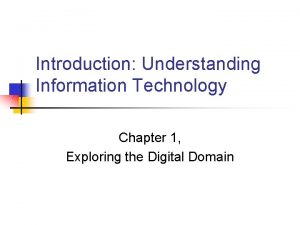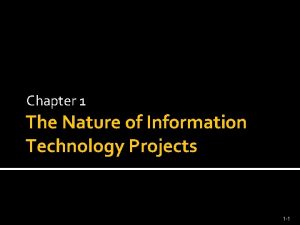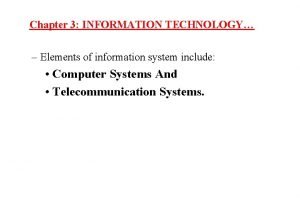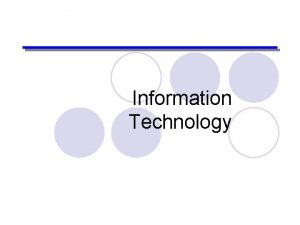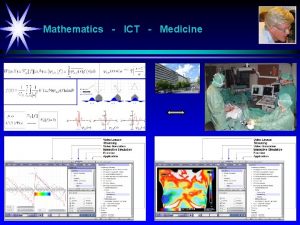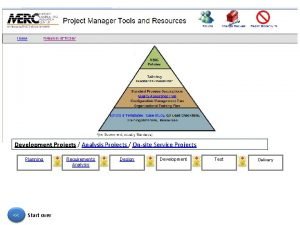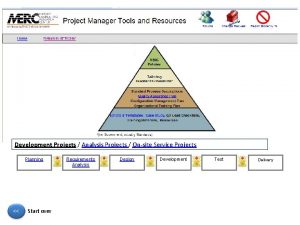Chapter 1 The Nature of Information Technology Projects






















- Slides: 22

Chapter 1 The Nature of Information Technology Projects 1 -1

IT and Modern Day Project Management 1940 s First Electronic Computer 1950 s 1960 s EDP Era 1970 s PC Era 1980 s 1990 s 2000 s Network Era 2010 s Globalization 1 -2

Introduction � Information Technology (IT) projects are organizational investments that require Time Money Other resources such as People, Technology, Facilities, etc. � Organizations expect some type of value in return for this investment (ROI) � IT Project Management is a relatively new discipline that attempts to make IT projects more successful and combines traditional Project Management with Software Engineering/Management Information Systems 1 -3

An ITPM (IT Project Management) Approach �Organizational resources are limited, so organizations must choose among competing interests to fund specific projects �This decision should be based on the value a competing project will provide to an organization 1 -4

Modern Project Management �Often credited to the U. S. Navy as an outgrowth of the Polaris Missile Project in the 1950 s �Focuses on reducing costs & product cycle time. �Provides an important link between an organization’s strategy and the deployment of that strategy. Can have a direct impact on an organization’s bottom line and competitiveness. 1 -5

Which Situation is Worse? �Successfully building and implementing a system that provides little or no value to the organization? Or… �Failing to implement an information system that could have provided value to the organization, but was underdeveloped or poorly managed? 1 -6

Why Many Projects Fail: Project Failure can be grouped into four categories (examples) People – The stakeholders of a project with varied roles and interests in the project’s success or failure. Processes – This includes having a set of project management and product management processes. Technology – Only 3% of IT project failures can be attributed to technical challenges but this percentage can be increased if obsolete, unproven, or incompatible technologies are used. Organization – Organizational issues can lead to project failure. A lack of clear direction, improper strategy, rapidly changing business environment and/or customer needs can create a moving target for the product’s product or service. 1 -7

Why Many Projects Fail: Project Failure can be grouped into four categories (examples) 1 -8

The Software Crisis �The CHAOS Study published in 1995 by The Standish Group found that although the U. S spent over $250 billion on IT projects … approximately: 31% were cancelled before completion 53% were completed but overbudget, over schedule, & did not meet original specifications ▪ For mid-size companies, average cost overruns were 182%, while average schedule overruns were 202%! 1 -9

Has the Current State of IT Projects Changed Since 1994? �The Standish Group has continued to study IT projects over the years. �IT Projects are showing higher success rates due to: Better project management tools & processes Smaller projects Improved communication among stakeholders More skillful IT project managers �But there is still ample opportunity for improvement! 1 -10

Table 1. 1 Summary of CHAOS Study Factor Rankings for Successful Projects Rank 1994 2001 2006 2008 1 User Involvement Executive Support User Involvement 2 Executive Management Support User Involvement Executive Management Support Executive Support 3 Clear Statement of Requirements Experienced Project Manager Clear Business Objectives 4 Proper Planning Clear Business Objectives Optimizing Scope Emotional Maturity 5 Realistic Expectations Minimized Scope Agile Process Optimizing Scope 6 Smaller Project Milestones Standard Software Infrastructure Project Management Expertise Agile Process 7 Competent Staff Firm Basic Requirements Financial Management Project Management Expertise 8 Ownership Formal Methodology Skilled Resources 9 Clear Vision & Objectives Reliable Estimates Formal Methodology Execution 10 Hard-working, focused team Other Standard Tools and Infrastructure Tools & Infrastructure 1 -11 Sources: Adapted from the Standish Group. CHAOS ; (West Yarmouth, MA: 1995, 2010) & http: //www. infoq. com/articles/Interview-Johnson-Standish-CHAOS

Table 1. 2: IT Project Success Criteria Response Schedule 61. 3% said it is more important to deliver a system when it is ready to be shipped than to deliver it on time. Scope 87. 3% said that meeting the actual needs of stakeholders is more important than building the system to specification. Money 79. 6% said that providing the best return on investment (ROI) is more important than delivering a system under budget. Quality 87. 3% said that delivering high quality is more important than delivering on time and on budget. Staff 75. 8% said that having a mentally and physically healthy workplace is more important than delivering on time and on budget. Source: http: //www. drdobbs. com/architecture-and-design/202800777. 1 -12

Table 1. 3: Summary of Factor Rankings for Challenged and Failed (Impaired) Projects Rank Factors for Challenged Projects Factors for Failed (Impaired) Projects 1 Lack of user input Incomplete requirements 2 Incomplete requirements Lack of user involvement 3 Changing requirements & specifications Lack of resources 4 Lack of executive support Unrealistic expectations 5 Technology incompetence Lack of executive support 6 Lack of resources Changing requirements & specifications 7 Unrealistic expectations Lack of planning 8 Unclear objectives Didn’t need it any longer 9 Unrealistic time frames Lack of IT management 10 New technology Technology illiteracy Source: Adapted from the Standish Group. CHAOS (West Yarmouth, MA: 1995) 1 -13

Figure 1. 2 When IT projects have gone wrong, what has been the reaction from the business managers & the Board of Directors? Don't know 1% None Looked for a scapegoat among IT staff Sought compensation from IT vendors Reluctant to fund new IT projects 2% 9% 13% 19% Reduced IT budgets 21% Tend to accept problems as the norm (i. e. , a necessary evil) Continued to provide support to improve IT 43% 1 -14 69%

Improving the Likelihood of Success � A Value-Driven Approach Plain & Simple: IT Projects must provide value to the organization � Socio-technical Approach It’s not just about the technology or building a better mouse trap � Project Management Approach processes and infrastructure (Methodology) resources expectations competition efficiency and effectiveness � Knowledge Management Approach 1 -15 lessons learned, best practices & shared knowledge

The Context of Project Management – Project Attributes � Time Frame � Purpose (to provide value!) � Ownership � Resources (the triple constraint) � Roles Project Manager Project Sponsor SME (Subject Matter Expert - domain & technical) � Risk & Assumptions � Interdependent Tasks Progressive elaboration – steps & increments � Planned Organizational Change � Operate in Environments Larger than the Project Itself 1 -16

The Triple Constraint Figure 1. 3 1 -17

Extreme Project Management (XPM) � A new approach & philosophy to project management that is becoming increasingly popular � Characterizes many of today’s projects that exemplify speed, uncertainty, changing requirements, and high risks � Traditional project management often takes an orderly approach while, XPM embraces the fact that projects are often chaotic and unpredictable � XPM focuses on flexibility, adaptability, and innovation � Traditional and new approaches together can provide us with a better understanding of how to improve the likelihood of project success 1 -18

The Project Management Body of Knowledge (PMBOK®) � The Guide to the Project Management Body of Knowledge (PMBOK® Guide) documents 9 project management knowledge areas � The PMBOK® Guide is published and maintained by the Project Management Institute (PMI) http: //www. pmi. org � PMI provides a certification in project management called the Project Management Professional (PMP) that many people today believe will be as relevant as a CPA certification � PMP certification requires that you pass a PMP certification exam to demonstrate understanding about project management, as well as satisfy education & experience requirements and agree to a professional code of conduct 1 -19

Project Management Body of Knowledge Areas Figure 1. 8 1 -20

The PMBOK® Guide’s Definitions for … • A project is a temporary endeavor undertaken to create a unique product, service, or result. • A project manager is the person assigned by the performing organization to achieve the project objectives. 1 -21

What is Project Management? � Project Management is the application of knowledge, skills, tools and techniques to project activities to meet project requirements. � Project Portfolio – a collection of diverse projects managed collectively to align with the organization’s strategy and overall plan to achieve competitive advantage. � Program – a collection of projects within a project portfolio whose activities are coordinated so that the benefits of the program are great than the sum of the benefits of the individual projects. 22
 Nature of information technology
Nature of information technology Nature of information technology
Nature of information technology Information technology chapter 3
Information technology chapter 3 Information technology the internet and you
Information technology the internet and you Chapter 1 information technology the internet and you
Chapter 1 information technology the internet and you Nature and nature's laws lay hid in night
Nature and nature's laws lay hid in night Nature nature controversy
Nature nature controversy Science technology and society module answer key
Science technology and society module answer key Nature and technology art
Nature and technology art Hình ảnh bộ gõ cơ thể búng tay
Hình ảnh bộ gõ cơ thể búng tay Frameset trong html5
Frameset trong html5 Bổ thể
Bổ thể Tỉ lệ cơ thể trẻ em
Tỉ lệ cơ thể trẻ em Voi kéo gỗ như thế nào
Voi kéo gỗ như thế nào Tư thế worm breton là gì
Tư thế worm breton là gì Chúa yêu trần thế
Chúa yêu trần thế Môn thể thao bắt đầu bằng chữ f
Môn thể thao bắt đầu bằng chữ f Thế nào là hệ số cao nhất
Thế nào là hệ số cao nhất Các châu lục và đại dương trên thế giới
Các châu lục và đại dương trên thế giới Công thức tính độ biến thiên đông lượng
Công thức tính độ biến thiên đông lượng Trời xanh đây là của chúng ta thể thơ
Trời xanh đây là của chúng ta thể thơ Mật thư tọa độ 5x5
Mật thư tọa độ 5x5 Phép trừ bù
Phép trừ bù
